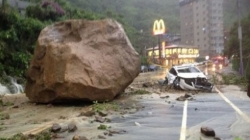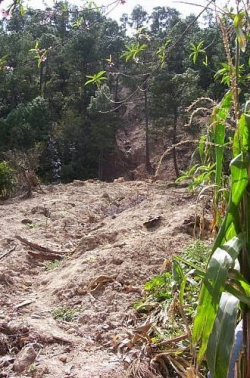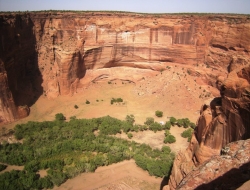Have you ever spent a lot of time drawing a picture and then when you go to hang it up, it just falls down? There's nothing more annoying than trying to hang your beautiful picture only to have it fall down over and over again. Maybe it's the tape or nail that you used to hang it up. Maybe it's the wall. Sometimes, though, things just fall down on their own because gravity is pulling them. If you think about it, gravity isn't just pulling down your picture. It's pulling down everything on Earth.
Gravity affects mostly everything in this world, even if it does not seem like it. In fact, gravity can sometimes make parts of the ground fall down when nothing is pushing them. We can see this when we drive up a mountain road. Sometimes big rocks will fall down with no warning! A rockfall is when one or more rocks fall from a cliff. When this happens, it can be very ugly. Roads may have to be closed down if a rockfall happens.

Next time we'll take my way.
If you ever get the chance to drive in the mountains, you might notice that some of the rocks are covered with nets. Sometimes these nets cover a whole cliff! Why would a cliff need a net? Well, the nets are there to protect the people driving on the roads, because bits of rock can fall down from the cliffs. Who knew that driving in the mountains could be so risky?
It's not just bits of rock that gravity pulls down. There are times when the land might begin to move on its own. A landslide is when rocks and dirt move downhill. This is more than just a couple of rocks. A landslide involves a lot of rocks and a lot of dirt. If you are near a landslide, that could be a very bad thing. Just like a rockfall, lots of dirt and rock moving downward can be dangerous.
However, it's not gravity alone that can cause a landslide. Gravity makes the water that's trapped high up in the clouds fall down to the ground and water can also help cause a landslide. When a lot of water is soaked up into the dirt, it makes the land really heavy and slippery. Have you ever tried to run uphill in mud? You might not get very far. When you have all that heavy mud sitting on top of a hill, gravity can give it the extra push. Then the land begins to fall downhill.

A landslide brings down everything.
Photo: Daniel Sanchez-Bustamante, Public domain, via Wikimedia Commons
Landslides happen fast and they are pretty easy to spot. On the other hand, there are times where the land might be moving downhill, but you cannot really notice it. Creep is when the ground slowly moves down a hill over a long time. This could take many, many years. Imagine a fence built on a hill. The ground begins to creep. After a while, the fence might begin to break in certain spots. That's when you know something funny is happening.
Have you ever played a game where you try to stack things to see how high you can go? Maybe you have stacked cards or even blocks of wood. The more stuff you put on top, the shakier your game gets. In fact, with just a little shake, the whole thing might come tumbling down. With the right shake, there are parts of land all around the world that might just come tumbling down.
We already talked about how dangerous landslides and rockfall can be, but when they things happen with lots of stuff, they can be pretty bad. Mass wasting is when gravity pulls parts of land or cliffs down. It can be caused by things like earthquakes, rivers or just the amount of stuff that's piled up on a hill. It can happen very slowly and over a long period of time or it can happen very fast.

These rocks have been wasting away for centuries.
Hold your arms up above your head. How long do you think you can keep your arms there? You most likely will not be able to do this for more than a few of minutes. This is because our friend gravity pushes everything down. Sometimes this can be a very good thing because gravity stops us from floating off into space. Sometimes it can be not such a great thing because it means that piles of rocks and land can fall anytime, anyplace.
References:
"Mass Wasting."
Science of Everyday Things. Encyclopedia.com, 2002.
http://www.encyclopedia.com/topic/Mass_wasting.aspxGeography4Kids (2013). "Break it Down."
Geography4Kids.com.
http://www.geography4kids.com/files/land_erosion.html
One Geology for Kids (2013). "Creep."
One Geology for Kids. http://www.onegeology.org/extra/kids/earthprocesses/creep.html